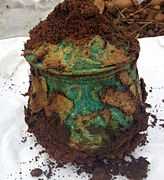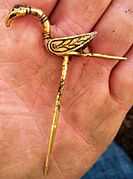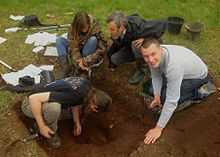Dumfriesshire Hoard

The Dumfriesshire Hoard, also known as the Galloway Hoard, is a hoard of more than 100 gold and silver objects from the Viking period discovered in Dumfries and Galloway in south-west Scotland in September 2014. Found on Church of Scotland land, the hoard has been described by experts as "one of the most significant Viking hoards ever found in Scotland".[1] It was discovered by a metal detector enthusiast who reported the find to the authorities. A county archaeologist carried out an excavation which revealed the presence of a variety of jewellery from various parts of the Viking world. It is thought that the hoard was buried some time in the mid-ninth or tenth century, though it is not known why it was buried. Its value is estimated to be approximately £1 million.
Discovery

The hoard was discovered at an undisclosed location on pastureland owned by the Church of Scotland.[2][3] It was found by Derek McLennan, a metal detectorist from Ayrshire.[1] He was accompanied by two churchmen, Rev Dr. David Bartholomew and Pastor Mike Smith, who were also metal detector enthusiasts.[3] The trio had permission to search the site, which McLennan had been investigating for more than a year, and he found a silver object, which turned out to be an arm ring, after an hour's searching. According to McLennan, "initially I didn't understand what I had found because I thought it was a silver spoon and then I turned it over and wiped my thumb across it and I saw the Saltire-type of design and knew instantly it was Viking."[1] He ran over to Bartholomew, shouting "Viking!"[4] It was not his first discovery; in 2013, McLennan had discovered Scotland's largest hoard of medieval silver coins near Twynholm.[1]
The find was reported to Scotland's Treasure Trove Unit[2] and a county archaeologist, Andrew Nicholson, undertook an excavation with McLennan's assistance. They dug further and found a collection of artefacts at a depth of 60 cm (24 in).[3] When the artefacts had been removed, McLennan carried out a further search with his metal detector and found a second level of the hoard, buried beneath the first. Among the finds was an early Christian silver cross. Bartholomew said, "It was tremendously exciting, especially when we noticed the silver cross lying face-downwards. It was poking out from under the pile of silver ingots and decorated arm-rings, with a finely wound silver chain still attached to it. It was a heart-stopping moment when the local archaeologist turned it over to reveal rich decoration on the other side."[4]
Items discovered
The hoard consists of a variety of gold and silver objects including armbands, a Christian cross, brooches, ingots, and what is possibly the largest silver Carolingian pot ever discovered. The items among the treasure originated across a wide geographic area that includes Ireland, Scandinavia, and central Europe. They were produced throughout an extended period of time–perhaps a couple of centuries–and the treasure was deposited in the mid-ninth or tenth centuries.[1] The hoard has some similarities with other Viking finds, but its mixture of gold, silver, glass, enamel, and textiles has been described by experts as unique.[5]
-

Carolingian silver alloy pot
-

Early medieval cross
-

Gold bird pin
-

Gold ring
The pot was one of the older items in the hoard and may have been more than 100 years old by the time it was deposited.[1] It was made of a silver alloy and was found wrapped in the remains of a cloth, with its lid still in place. It contains more objects and was examined using X-rays in November 2014 before being opened and emptied. The contents were found to be a collection of brooches, exotic beads, a gold ingot, a folded silver sheet and "two mystery items".[6] The vessel may have been an heirloom owned by the family that buried the hoard.[3][7] The silver cross may have come from Dublin[2] and is engraved with unusual decorations on each of the four arms, which McLennan has suggested may represent each of the four Gospels.[4]
Context and further excavations
Following the discovery of the hoard, Historic Scotland, the National Museum and the archaeological contractors AOC Archaeology agreed that a wider archaeological investigation was needed to find out more about the hoard's context. The site was put under 24 hour security and a local farmer put his biggest bull in the field to deter intruders. A 30m by 30m trench was dug, centred on the findspot. Over a hundred more objects were discovered including a silver ingot, a complete silver bracelet, fragments of another silver bracelet and small pieces of silver, iron and copper alloy plus fragments of daub, suggesting the presence of a building. A geophysical survey carried out by Glasgow University revealed that the hoard had been buried under the corner of a rectangular timber building outlined by a double row of posts. It is not known whether there was any link between the hoard and the building, or whether the building was coincidentally constructed over the hoard at a later date.[6]
The survey and earlier aerial photography showed that the building had been constructed within a large, rectilinear double-ditched enclosure which was partitioned by a separate enclosure. According to historical sources, an early Christian ecclesiastical foundation was located nearby and the hoard's site may have been associated with monastic activity. These findings prompted Historic Scotland to schedule the whole field as a site of national importance in September 2014.[6]
Reactions, analysis and disposal

The hoard has been described by experts as "one of the most significant Viking hoards ever found in Scotland".[1] According to Stuart Campbell of the National Museum of Scotland, "This is a hugely significant find, nothing like this has been found in Scotland before in terms of the range of material this hoard represents."[1] He comments that "due to the quantity and variety of the objects, and the importance of the find overall, it will take some time for experts to assess the hoard as a whole so that we can appreciate its true significance. We look forward to learning more."[3]
The reason for the hoard's burial is unknown, but Campbell has suggested that it was buried for safekeeping, likening it to "a safety deposit box that was never claimed".[7] He comments that the discovery may change views of the historical relationship between Scotland and the Vikings: "We have the idea of Vikings as foreigners who carried out raids on Scotland, but this was a Viking area where they settled and traded, and the people who lived there were culturally and linguistically Norse."[7]
It is also not clear why the hoard was buried in two discrete levels. It may simply have been buried in two instalments at different times, presumably by the same individual. Alternatively, the burier may have sought to ensure that the more valuable objects – the gold items and the Carolingian pot – were more deeply buried, and thus more secure. The contents of the two levels of the hoard are dissimilar; the upper level of the hoard consists of smaller and less valuable items which would have been the equivalent of "loose change" in the Viking bullion economy, while the lower level represents a much rarer and more exotic collection of valuables.[6]
The hoard falls under the Scottish common law of treasure trove and is being held by the Treasure Trove Unit of the National Museum of Scotland. The law entitles the finder to a reward related to the market value of the items discovered. McLennan and the landowners, the Church of Scotland's General Trustees, have agreed to share the eventual proceeds.[3] Although the finds are still being examined, it is thought that their total value may be approximately £1 million.[2] David Robertson, the Secretary to the General Trustees, has said that "any money arising from this will first and foremost be used for the good of the local parish."[3]
See also
References
| Wikimedia Commons has media related to Dumfriesshire Hoard. |
- ↑ 1.0 1.1 1.2 1.3 1.4 1.5 1.6 1.7 "Viking treasure haul unearthed in Scotland". BBC News. 12 October 2014. Retrieved 12 October 2014.
- ↑ 2.0 2.1 2.2 2.3 Wade, Mike (12 October 2014). "Treasure hunter finds Viking hoard". The Times. Retrieved 12 October 2014.
- ↑ 3.0 3.1 3.2 3.3 3.4 3.5 3.6 "Viking treasure hoard found in Dumfries and Galloway". Sunday Herald. 12 October 2014. Retrieved 12 October 2014.
- ↑ 4.0 4.1 4.2 "Spectacular Viking treasure hoard found on Church land". Church of Scotland. 12 October 2014. Retrieved 12 October 2014.
- ↑ Ross, Shan (13 October 2014). "Viking treasure hoard found in Scotland". The Scotsman. Retrieved 13 October 2014.
- ↑ 6.0 6.1 6.2 6.3 Owen, Olwyn (January–February 2015). "Galloway's Viking treasure: the story of a discovery". British Archaeology (140). pp. 16–23.
- ↑ 7.0 7.1 7.2 Brooks, Libby (13 October 2014). "Metal-detecting enthusiast unearths Viking treasure hoard in Scotland". The Guardian. Retrieved 13 October 2014.
| ||||||||||||||||||||||||||||||||||||||||||||||